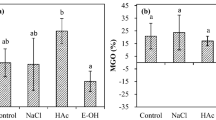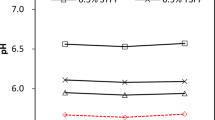Abstract
This work aimed to investigate the effects of stored raw meat and process procedures on Nε-carboxymethyl-lysine (CML) and Nε-carboxyethyl-lysine (CEL) generation in meat products. Meat products of raw pork were sterilized and pasteurized at different storage times (0-4 months) and the CML/CEL contents were determined. The results showed that the extent of lipid and protein oxidation of raw pork increased with increasing storage time. A linear correlation was found between thiobarbituric acid-reactive substances value/carbonyl content and CML/CEL in sterilized meat products, indicating that stored raw pork could promote CML/CEL formation under high temperature processing. Furthermore, mild heating temperatures seemed to favor CML formation, while high temperature could accelerate CEL generation. Therefore, formation kinetics of CML and CEL might be different for different process procedures. These results suggested that stored raw meat and processing temperature could significantly affect CML and CEL generation in meat products.
Similar content being viewed by others
References
Singh R, Barden A, Mori T, Beilin L. Advanced glycation end-products: A review. Diabetologia 44: 129–146 (2001)
Li M, Zeng M, He Z, Zheng Z, Qin F, Tao G, Zhang S, Chen J. Increased accumulation of protein-bound Nε-(carboxymethyl) lysiNε in tissues of healthy rats after chronic oral Nε-(carboxymethyl) lysiNε. J. Agr. Food Chem. 63: 1658–1663 (2015)
Yamagishi S, Matsui T, Nakamura K. Possible link of food-derived advanced glycation end products (AGEs) to the development of diabetes. Med. Hypotheses 71: 876–878 (2008)
Takeuchi M, Yamagishi SI. Possible involvement of advanced glycation endproducts (AGEs) in the pathogeNεsis of Alzheimer’s disease. Curr. Pharm. Design 14: 973–978 (2008)
Sun X, Tang J, Wang J, Rasco BA, Lai K, Huang Y. Formation of advanced glycation endproducts in ground beef under pasteurisation conditions. Food Chem. 172: 802–807 (2015)
Chen G, Smith JS. Determination of advanced glycation endproducts in cooked meat products. Food Chem. 168: 190–195 (2015)
Poulsen MW, Hedegaard RV, Andersen JM, de Courten B, Bügel S, Nielsen J, Skibsted LH, Dragsted LO. Advanced glycation endproducts in food and their effects on health. Food Chem. Toxicol. 60: 10–37 (2013)
Hull GL, Woodside JV, Ames JM, Cuskelly GJ. Nε-(carboxymethyl)lysiNε content of foods commonly consumed in a Western style diet. Food Chem. 131: 170–174 (2012)
Cheng L, Jin C, Zhang Y. Investigation of Variations in the Acrylamide and Nε-(Carboxymethyl) LysiNε Contents in Cookies during Baking. J. Food Sci. 79: T1030–T1038 (2014)
Goldberg T, Cai W, Peppa M, Dardaine V, Baliga BS, Uribarri J, Vlassara H. Advanced glycoxidation end products in commonly consumed foods. J. Am. Diet. Assoc. 104: 1287–1291 (2004)
Lima M, Assar SH, Ames JM. Formation of Nε-(carboxymethyl) lysiNε and loss of lysiNε in casein glucose-fatty acid model systems. J. Agr. Food Chem. 58: 1954–1958 (2010)
Fu Q, Li L, Li B. Formation of Nε-(Carboxymethyl) lysiNε in saccharide-lysiNε model systems by different heat treatments. Int. J. Food Eng. 8: 12578–12570 (2012)
Han L, Li L, Li B, Zhao D, Li Y, Xu Z, Liu G. Glyoxal derived from triglyceride participating in diet-derived Nε-carboxymethyllysiNε formation. Food Res. Int. 51: 836–840 (2013)
Martin J, Brooks J, Brooks T, Legako J, Starkey J, Jackson S, Miller M. Storage length, storage temperature, and lean formulation influence the shelf-life and stability of traditionally packaged ground beef. Meat Sci. 95: 495–502 (2013)
Utrera M, Parra V, Estévez M. Protein oxidation during frozen storage and subsequent processing of different beef muscles. Meat Sci. 96: 812–820 (2014)
Cheon HS, Cho WI, Yi JY, Chung MS. Optimization of sterilization conditions for retorted meatballs based on prediction of heat peNεtration. Food Sci. Biotechnol. 24: 1661–1666 (2015)
Desmond EM, Kenny TA. Effect of pelvic suspension and cooking method on the processing and sensory properties of hams prepared from two pork muscles. Meat Sci. 69: 425–431 (2005)
AOAC. Official Method of Analysis of AOAC Intl. 16th ed. Method 928.08. Association of Offical Analytical Chemists, Gaithersburg, MD, USA (2002)
AOAC. Official Method of Analysis of AOAC Intl. 17th ed. Method 950.46. Association of Official Analytical Chemists, Gaithersburg, MD, USA (2002)
Wang LL, Xiong YL. Inhibition of lipid oxidation in cooked beef patties by hydrolyzed potato protein is related to its reducing and radical scavenging ability. J. Agr. Food Chem. 53: 9186–9192 (2005)
Park D, Xiong YL, Alderton AL. Concentration effects of hydroxyl radical oxidizing systems on biochemical properties of porciNε muscle myofibrillar protein. Food Chem. 101: 1239–1246 (2006)
Gornall AG, Bardawill CJ, David MM. Determination of serum proteins by means of the biuret reaction. J. Biol. Chem. 171: 751–766 (1949)
Liu G, Xiong YL, Butterfield DA. Chemical, physical, and gel-forming properties of oxidized myofibrillar, whey, and soy protein isolates. J. Food Sci. 65: 811–818 (2000)
Zhang G, Huang G, Xiao L, Mitchell AE. Determination of advanced glycation endproducts by LC-MS/MS in raw and roasted almonds (Prunus dulcis). J. Agr. Food Chem. 59: 12037–12046 (2011)
Kong B, Zhang H, Xiong YL. Antioxidant activity of spice extracts in a liposome system and in cooked pork patties and the possible mode of action. Meat Sci. 85: 772–778 (2010)
Brewer MS, Ikins W, Harbers C. TBA values, sensory characteristics, and volatiles in ground pork during long-term frozen storage: Effects of packaging. J. Food Sci. 57: 558–563 (1992)
Vieira C, Diaz MY, Martínez B, García-Cachán MD. Effect of frozen storage conditions (temperature and length of storage) on microbial and sensory quality of rustic crossbred beef at different stages of aging. Meat Sci. 83: 398–404 (2009)
Stadtman ER. Protein oxidation and aging. Free Radical Res. 40: 1250–1258 (2006)
Stadtman ER, Levine RL. Free radical-mediated oxidation of free amino acids and amino acid residues in proteins. Amino Acids 25: 207–218 (2003)
Estévez M. Protein carbonyls in meat systems: A review. Meat Sci. 89: 259–279 (2011)
Srey C, Hull GL, Connolly L, Elliott CT, del Castillo MD, Ames JM. Effect of inhibitor compounds on Nε-(Carboxymethyl)lysiNε (CML) and Nε-(Carboxyethyl)lysiNε (CEL) formation in model foods. J. Agr. Food Chem. 58: 12036–12041 (2010)
Arribas-Lorenzo G, Morales FJ. Analysis, distribution, and dietary exposure of glyoxal and methylglyoxal in cookies and their relationship with other heatinduced contaminants. J. Agr. Food Chem. 58: 2966–2972 (2010)
Ahmed N, Mirshekar-Syahkal B, Kennish L, Karachalias N, Babaei-Jadidi R, Thornalley PJ. Assay of advanced glycation endproducts in selected beverages and food by liquid chromatography with tandem mass spectrometric detection. Mol. Nutr. Food Res. 49: 691–699 (2005)
Li CQ, Xiong YL, Chen J. Oxidation-induced unfolding facilitates myosin crosslinking in myofibrillar protein by microbial transglutaminase. J. Agr. Food Chem. 60: 8820–8827 (2012)
Fu MX, Requena JR, Jenkins AJ, Lyons TJ, Baynes JW, Thorpe SR. The advanced glycation end product, Nε-(carboxymethyl)lysiNε, is a product of both lipid peroxidation and glycoxidation reactions. J. Biol. Chem. 271: 9982–9986 (1996)
Author information
Authors and Affiliations
Corresponding author
Rights and permissions
About this article
Cite this article
Yu, L., Gao, C., Zeng, M. et al. Effects of raw meat and process procedure on Nε-carboxymethyllysine and Nε-carboxyethyl-lysine formation in meat products. Food Sci Biotechnol 25, 1163–1168 (2016). https://doi.org/10.1007/s10068-016-0185-5
Received:
Revised:
Accepted:
Published:
Issue Date:
DOI: https://doi.org/10.1007/s10068-016-0185-5




